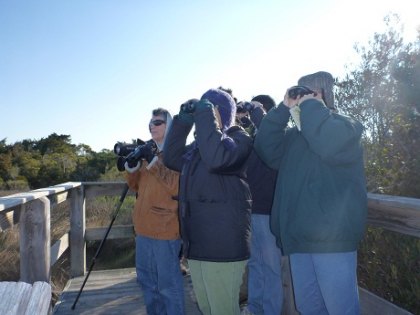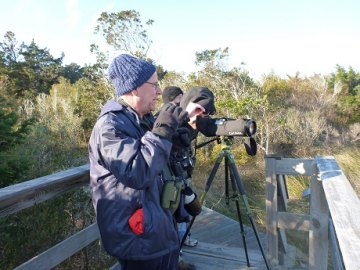
Not all migratory Ocracoke birds feature on bumper stickers with a slash through them.
The many hunters and other nature lovers on Ocracoke are skilled at reading flight patterns and have long observed avian habits and habitats.
For the past decade I have tried, in fits and starts, with little success, to learn about birds. When Peter Vankevich offered to host a weekly Thursday bird walk, I hauled myself from my nest of blankets to meet him and a small group for the 8 a.m. start.
Peter began the annual Christmas bird count on Ocracoke in 1981, the first year he visited, spotted a swallow tailed kite, rare for NC, and fell in love with Ocracoke. He started a bird count on Portsmouth in 1988. He and his wife Mary bought a home on Ocracoke in 1999 and now live here year round.
An eager, knowledgable and patient teacher, Peter introduced beginners to common winter residents and educated us about the habits of good birders. Peter shared binoculars with those who didn't have them. There were plenty of field guides to go around. A careful observer of the natural world, Peter writes the "Spotted on Ocracoke" column for the Ocracoke Observer.
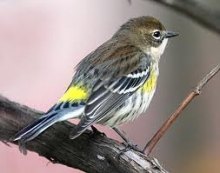
We began at the nature trail, where the first species we saw was the myrtle, or yellow rumped, warbler. Warblers are normally insect eaters, but the yellow rumped warbler has adapted to eating seeds, and are easily spotted in the branches of --you guessed it-- myrtle bushes.
They make a little chip note, and sort of bounce when they fly. They have a cute spot of bright yellow on their--wait for it--rump. After Hurricane Isabel blew through in 2003, knocking berries from the trees it took a few years for yellow rumped warblers to return in large numbers.
Remember the great flocks of crows that used to squawk and shuffle on utility wires? Peter asked. Their numbers are reduced, and bird biologists suspect West Nile virus is responsible, he said.
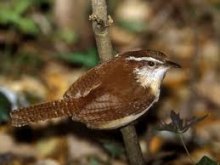
We paused by the creek across from the campground, where Peter has seen moorhens, grebes, coots and kingfishers. Kestrels migrate through Ocracoke, but no longer seem to winter here.
Cormorants are here by the thousands each winter. But you knew that, didn't you?
"Tune your ears," said Peter, who loves birding by ear, especially when spring makes everything sing. A Carolina wren is a "quick suspect" when you hear a loud bird singing on a winter midday, he said. We heard one singing about winter comfort: "teakettle teakettle teakettle tea."
American robins are abundant in the village. The flocks often mingle with the strikingly handsome cedar waxwing,
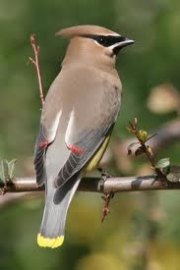
because they share food supples. Remember about ten years ago when huge numbers of waxwings came through and crashed into windows and skylights? That's because there had been a hard freeze, and the juniper berries fermented. Waxwings aren't any better at navigating drunk than humans, it seems.
Peter encourages new birders to familiarize themselves with familiar species. Know your flight patterns, he said, it will be easier to pick out variations and know when you've spotted a less common bird.
In the thicker scrub of the nature trail we watched and listened for Eastern towhees, who were not active on the windy day. Catbirds also winter on Ocracoke, in small numbers.
Everyone who lives here should be able to identify a laughing gull by both its shriek and appearance. These "wimpy" birds molt and lose their striking black caps in September, hang around like seasonal workers until November, and move to the Caribbean until March.
From the marsh overlook we saw a majestic great blue heron perched in a cedar,
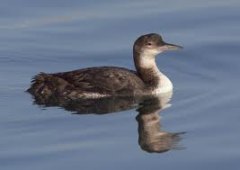
and a common loon chillin' on the sound. A common loon has been making Silver Lake its winter residence, said Peter. In later spring, just before they head north, the common loons can sometimes be seen with their distinctive black and white markings. Bill Jones spotted a red throated loon in flight.
The tall pines at the nature trail are "one of the best spots in NC" to hear the redbreasted nuthatch. Peter suspects they may have stayed further north for this mild winter, as these birds are "chatty, nasal and vocal." Sound like anyone you know?
It shouldn't be difficult to spot one of Ocracoke's most recent transplants, the Eurasian collared dove. Look for "a mourning dove on steroids" that are more greyish, enjoy perching on wires, and have a flat tail in flight. These robust birds have been around for about three years, and their numbers are greatly increasing.
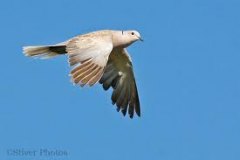
Carol Pahl, another experienced birder, was also on the walk. She said sighting an endangered wood stork, last fall, was one of the most exciting birds she's seen on Ocracoke.
Even though the birds we saw were modest, the company was great, wrote Peter in his email invitation to next week's walk, which begins with the group meeting in the Variety Store parking lot at 8 a.m. on Thursday. We will carpool to the north end to see what there is to see!
Everyone is welcomed to join. Please contact Peter at petevankevich@gmail.com to get on the mailing list and let him know if you plan to attend.
